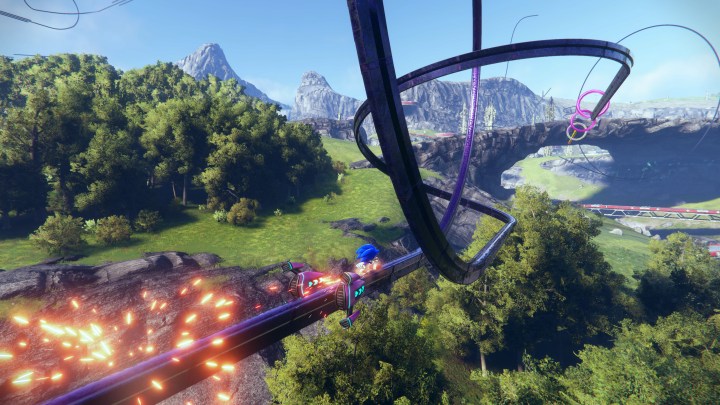
Considering that Sonic has a need for speed, it’s rare that you ever see the blue blur standing in one place for too long. That trait seems to have rubbed off on the series’ developers, Sonic Team, who seem averse to the idea of comfort zones. Rather than finding one formula that works and sticking to it, the studio has always kept the franchise on its feet by zooming straight ahead. Sometimes, that attitude leads to positive results. Other times, it’s a recipe for disaster. But for what it’s worth, you can’t accuse the Sonic franchise of being boring.
Sonic Frontiers is set to continue that trend. The “open-zone” game is incredibly experimental by Sonic standards, trading in linear levels for an expansive 3D world. It’s a strategic shift that throws decades of Sonic history out the window, a move that’s led to equal parts excitement and confusion among the hedgehog’s most faithful fans.
In an interview with Digital Trends, legendary Sonic director Takashi Iizuka explained why Sonic Team was so eager to start from scratch with Sonic Frontiers. The director sees the title as a necessary evolution to keep the series moving, one that he says is here to stay.
What’s an open-zone?
When approaching Sonic Frontiers, Iizuka and the developers at Sonic Team wanted to start from scratch. If the studio was really going to bring Sonic into the future, it’d have to take a fresh approach rather than repeating previous success or iterating on ideas that didn’t fully work the first time around. The project would call for such a drastic overhaul that the studio would even scrap the franchise’s trademark Saturday morning cartoon vibe.
“The concept started after the development of Sonic Forces,” Iizuka tells Digital Trends. “We sat down and said ‘This linear style of gameplay is really good, but I don’t know if it’s going to be good enough for our next game.’ We needed to think about some points of evolution.”
Just like the Adventure series was the second generation of Sonic titles, we’re looking at Frontiers as the third generation.
By the time Sonic Forces launched in 2017, The Legend of Zelda: Breath of the Wild had already become something of a “game of the year” lock. While Sonic Frontiers may look — and even sound — similar to it, Iizuka is careful not to speak its name as we chatted. That’s because he doesn’t want players to mistake Frontiers for an open-world game. When I ask what appeals to him about the genre, he’s quick to lay out what makes the game’s “open-zone” approach different.
“A lot of people are thinking our game is an open-world game, but it’s an open-zone game,” Iizuka insists.
“When we talk about open-world games, there’s this big map and you’re at point A but you need to get over to point B. They’re more about walking for a long time to get to the next city and then you get there and that’s where the world stuff happens. That’s the exact opposite of what we’re thinking. The open-zone is more of a playground. We’re making a huge area that’s filled with places to run around and play in. It’s not like you have to get to a city and ride a horse to get there. You get to play everywhere you go, so the movement and the action is the fun, not getting to the next city.”

It may sound like he’s splitting hairs, but it does check out. Sonic Frontiers’ mysterious island is built like a playground with different attractions dotted through the world. During my time with a demo for it, I didn’t feel like I was moving toward the next big hub. Rather, I was stopping at various platforming rides and enemy encounters laid out across the vast field. While I completed those, I also happened to be moving further into the island naturally.
Linear level design isn’t the only thing that Sonic Team dismantled to make Frontiers. For instance, the game’s tone is a major departure for the series. It’s quiet, almost somber, compared to the flashy vibrancy of previous titles. Iizuka says the team wanted to create a sense of mystery in Frontiers, which dictated the tonal shift. That approach would mean something else would need to change too: Fewer friends. While previous Sonic games feature a host of colorful characters, playable and not, Frontiers is solely focused on Sonic to create a sense of alienation.
“You start the game and you don’t know anything about why you’re on the island or what it is, just like Sonic doesn’t know,” Iizuka says. “Past games would have other friends or storytellers that would tell you what was going on, but that defeats the purpose of the mystery we were working on.”
Third generation
The open-zone concept isn’t designed to be a one-and-done experiment. At one point, Iizuka mentions that it’ll lay the groundwork for future games. When I ask if Sonic Team plans on sticking with this format, he confirms that Frontiers is the start of a new design era.
“Just like the Adventure series was the second generation of Sonic titles, we’re looking at Frontiers as the third generation,” Iizuka says. “It’ll really be that new format we’re building off of from here on out.”
We see it as the true path forward for Sonic.
That makes the stakes much higher for Sonic Team. The company is planning the future of the franchise around Frontiers, an untested design approach that’s already drawing skepticism. What makes that especially nerve-racking is that the studio couldn’t simply pull from tricks it knew would work or follow fan feedback to improve features from old games. Instead, it’s plunging in blind and trusting that fans will be willing to go along for the long journey.
“It was a little bit scary because we’re starting from zero. It’s like, what are we even making?” Iizuka says. “Everyone had a similar vision, but it’s not like previous games where you can just say ‘You know that one part in that game that people didn’t like?’ and everyone knows exactly what they’re talking about. Everyone’s talking about something that doesn’t exist, so our vision doesn’t immediately match up. There wasn’t that shared vision.”
“There is nothing that really exists like Sonic Frontiers,” Iizuka says.
Some may roll their eyes at that last line, but Iizuka is confident in the claim. Though the early design process was a little uncomfortable, Iizuka notes that Sonic Team is in a more fun place now that they’ve created something tangible, one that’ll set up future sequels for success if the team plays their cards right.

“We can start taking what we have for the next title and quickly saying ‘Hey, remember that thing from Frontiers? Let’s try to do this and that.’ So the next title will be even easier to iterate on.”
Iizuka’s philosophy might frustrate some players who just want to play Sonic Adventure 3 or a classic platformer in the vein of Sonic Mania. But the producer believes that the constant change is what defines the series more than any specific gameplay format. In a backward way, Sonic Frontiers is perhaps the most faithful Sonic title because it’s so resistant to repeating history.
“We don’t like making the same things over and over again,” Iizuka says. “We think the fans also don’t want more of the same over and over again repackaged. We see it as the true path forward for Sonic. We need to keep innovating and presenting the fans with something new and interesting, because they want and enjoy that. That’s why we’ve been around for 32 years.”



